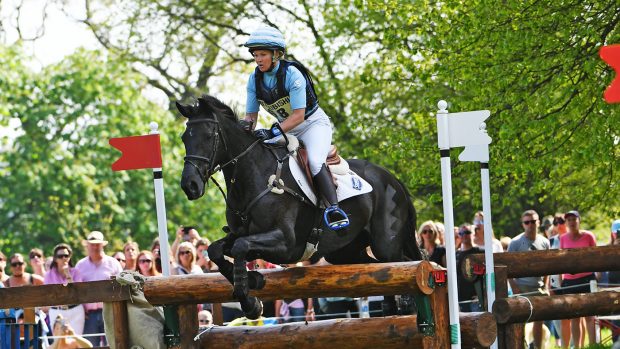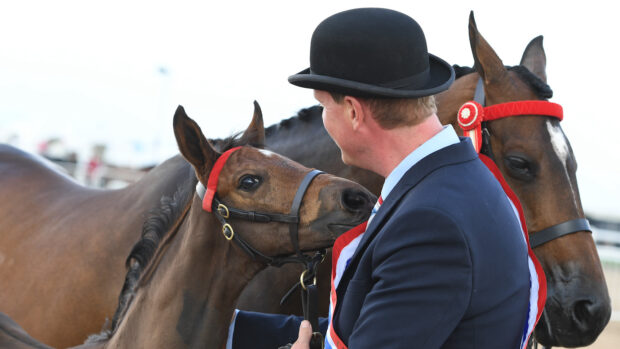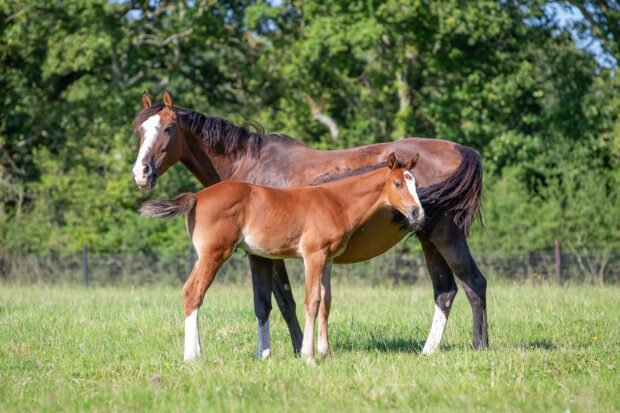Sara Longworth of Waverley Stud offers advice on what to look for when selecting a future competition prospect
So you’ve decided you want to buy a foal with potential. Here Sara Longworth of Waverley Stud provides advice on what to look for when selecting a future competition prospect.
Watching a foal mature from a playful baby into a strong, healthy four-year-old, ready for young horse classes, remains one of the most rewarding experiences for any rider or owner, to be enjoyed with the highs and lows along the way.
When looking to purchase a foal there are many things to think about, and often the best place to start is with you. How confident and proficient a rider are you? How far do you want to go in the sport? What kind of horse do you like to ride and has given you your best results? What sort of support do you have in terms of training?
It is no use buying a hot, spectacularly moving youngster if the temperament will unnerve you when it comes to the time to get on, or throw you off balance in the sitting trot.
Being clear about your requirements when you start looking for any new horse is important, but when it is a baby you can’t try, it’s crucial. So what else is there to consider?
For us the mare is paramount – in many ways the most important part of the equation. Not only will she supply half the genes, but she will carry the foal for nearly 11 months and nurture it for at least its first six months helping to form the foal’s initial experiences and behaviours.
A sensible mare will often produce sensible children, if paired with the right stallion!

An elite Oldenburg stallion prospect out of an elite, premium mare
A few points to consider:
• Mares are like stallions from a breeding perspective: they should possess traits that the breeder wants to replicate (e.g. conformation, gaits or ‘rideability’) in the progeny. This is the only reason to use a mare and the only reason to use a stallion.
• Look at the mare and be honest with yourself! Is she a type you personally like? Do you see traits you would like replicated in a horse you would like to own? Has the foal inherited them?
• Are there any other offspring available for you to look at so that you can see if points of outstanding conformation (or otherwise) are reliably passed on to her children?
• Bloodlines are key, and so are mare families. Take time to look into their history and go back as far as you can. For example one of our 1A State Premium Mares, Waverley Dalloway, is from the Aricia damline, which goes back to 1901 and has earned well in excess of €1million. She is the child of Elite and State Premium mares and also full sister to the Hannoverian mare champion of 2011 in Verden and to a stallion which licensed in Verden in 2012.
Credentials like this increase the chances that her offspring will also have potential. Three of our mares are Elite as well as State Premium — having been awarded the title through the quality of their offspring, i.e. because they have bred licensed stallions or other state premium mares or successful dressage horses; and their families number numerous licensed stallions and sport horses.
Again, associations like this increase the chances that new offspring will be trainable and of the right  quality. If the grandmothers were not quality mares there is a chance the offspring won’t be either. Many people look like their grandparents — it is the same with horses!
quality. If the grandmothers were not quality mares there is a chance the offspring won’t be either. Many people look like their grandparents — it is the same with horses!
• Temperament and trainability in a dressage horse are key — so look carefully at these two aspects in the mare and any of her existing offspring. Remember sharpness is not synonymous with lack of trainability. A placid dull horse can also be hard to train.
Sharp horses can be bold, very clever and very trainable, but they need experienced handling and have to be right for the buyer. A good indication of trainability is that the foal or young horse should have done everything asked of it to date — successfully!
What and how much it has been asked to do will be age dependent. This will often be dependent on its ability to trust the humans around him or her — and breeders must begin to earn the trust of their foals from the first minutes and hours of a foals life.
• Good conformation would be next in importance; whatever the future holds for your foal, it has to be physically capable of doing the job. The movement of foals, even within the first six months, will indicate whether their conformation will allow them to ‘sit’ for the higher movements in dressage; and whether or not they are athletic enough to do tempi changes, and extend and collect within the pace. Conversely poor conformation can increase the risk of injury, especially if the goal is high level competition.
• How important are flamboyant gaits? For some they are a must — but they are not always a sure indication of future talent. Carl Hester always says that Valegro had a very unremarkable trot when he selected him; but most professionals will look for a good canter and a good walk (‘good’ being defined by activity, rhythm and swing).
At Waverley Stud, Sara aims to breed five or six quality foals per year — concentrating on quality not quantity.
Sara said: “Our aim is to produce a high quality foal with the best bloodlines, that will be capable of performing at the highest level in the world of dressage.
“There is no perfect horse. But as a breeder, our reputation depends on the quality of the foals we can offer and our aim is to always produce the very best youngsters we can by selecting the right stallion to compliment and improve each of our supremely well qualified ladies.
“Stallions must self-evidently bring something to the party in terms of their conformation, type and gaits, but must also be performance tested through excellence in sport or their own rigorous performance testing process (licensing alone is not enough, for us, to justify using them).
“2015 looks set to be an exciting year as the stud grows with more broodmares and some fantastically bred foals to look forward to.”



